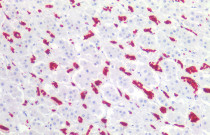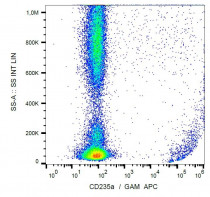ARG62780
anti-CD235a antibody [HIR2]
anti-CD235a antibody [HIR2] for Agglutination,CyTOF®-candidate,Flow cytometry,IHC-Frozen sections,IHC-Formalin-fixed paraffin-embedded sections and Human
Cell Biology and Cellular Response antibody
Overview
| Product Description | Mouse Monoclonal antibody [HIR2] recognizes CD235a |
|---|---|
| Tested Reactivity | Hu |
| Tested Application | Agg, CyTOF®-candidate, FACS, IHC-Fr, IHC-P |
| Specificity | The clone HIR2 recognizes N-terminal portion of glycophorin A (and weakly of glycophorin B). Its antigen is expressed on early erythroblasts, late erythroblasts, erythroblasts, mature erythrocytes and the cells of erythroid cell lines K562 and HEL, but not on all other cells. HLDA VII; WS Code 70299 |
| Host | Mouse |
| Clonality | Monoclonal |
| Clone | HIR2 |
| Isotype | IgG2b |
| Target Name | CD235a |
| Antigen Species | Human |
| Immunogen | Synthetic peptide (Human, N-terminal) |
| Conjugation | Un-conjugated |
| Alternate Names | MN; GPErik; MNS; GPA; GPSAT; PAS-2; MN sialoglycoprotein; CD235a; HGpMiV; CD antigen CD235a; HGpMiXI; Sialoglycoprotein alpha; HGpSta(C); Glycophorin-A |
Application Instructions
| Application Suggestion |
|
||||||||||||
|---|---|---|---|---|---|---|---|---|---|---|---|---|---|
| Application Note | Flow Cytometry: This HIR2 antibody has been tested by flow cytometric analysis of human peripheral blood leukocytes and cell agglutination assay and can be used at approximately 0.1 μg per million cells. Agglutination: The antibody HIR2 agglutinates untreated RBCs but failes to agglutinate papain-treated cells. * The dilutions indicate recommended starting dilutions and the optimal dilutions or concentrations should be determined by the scientist. |
Properties
| Form | Liquid |
|---|---|
| Purification | Purified by protein A |
| Purity | > 95% (by SDS-PAGE) |
| Buffer | PBS (pH 7.4) and 15 mM Sodium azide |
| Preservative | 15 mM Sodium azide |
| Concentration | 1 mg/ml |
| Storage Instruction | For continuous use, store undiluted antibody at 2-8°C for up to a week. For long-term storage, aliquot and store at -20°C or below. Storage in frost free freezers is not recommended. Avoid repeated freeze/thaw cycles. Suggest spin the vial prior to opening. The antibody solution should be gently mixed before use. |
| Note | For laboratory research only, not for drug, diagnostic or other use. |
Bioinformation
| Database Links | |
|---|---|
| Gene Symbol | GYPA |
| Gene Full Name | glycophorin A (MNS blood group) |
| Background | CD235a (Glycophorin A, GPA) is a transmembrane sialoglycoprotein expressed on erythrocytes and their precursors. Similarly to glycophorin B (GPB), these molecules provide the cells with a large mucin-like surface, which minimalizes aggregation between erythrocytes in the circulation. GPA is the carrier of blood group M and N specificities, while GPB accounts for S, s and U specificities. CD235a is a receptor of Hsa, an Streptococcus adhesin. |
| Function | Glycophorin A is the major intrinsic membrane protein of the erythrocyte. The N-terminal glycosylated segment, which lies outside the erythrocyte membrane, has MN blood group receptors. Appears to be important for the function of SLC4A1 and is required for high activity of SLC4A1. May be involved in translocation of SLC4A1 to the plasma membrane. Is a receptor for influenza virus. Is a receptor for Plasmodium falciparum erythrocyte-binding antigen 175 (EBA-175); binding of EBA-175 is dependent on sialic acid residues of the O-linked glycans. Appears to be a receptor for Hepatitis A virus (HAV). [UniProt] |
| Highlight | Related products: CD235a antibodies; Anti-Mouse IgG secondary antibodies; Related news: CyTOF-candidate Antibodies |
| Research Area | Cell Biology and Cellular Response antibody |
| Calculated MW | 16 kDa |
| PTM | The major O-linked glycan are NeuAc-alpha-(2-3)-Gal-beta-(1-3)-[NeuAc-alpha-(2-6)]-GalNAcOH (about 78 %) and NeuAc-alpha-(2-3)-Gal-beta-(1-3)-GalNAcOH (17 %). Minor O-glycans (5 %) include NeuAc-alpha-(2-3)-Gal-beta-(1-3)-[NeuAc-alpha-(2-6)]-GalNAcOH NeuAc-alpha-(2-8)-NeuAc-alpha-(2-3)-Gal-beta-(1-3)-GalNAcOH. About 1% of all O-linked glycans carry blood group A, B and H determinants. They derive from a type-2 precursor core structure, Gal-beta-(1,3)-GlcNAc-beta-1-R, and the antigens are synthesized by addition of fucose (H antigen-specific) and then N-acetylgalactosamine (A antigen-specific) or galactose (B antigen-specific). Specifically O-linked-glycans are NeuAc-alpha-(2-3)-Gal-beta-(1-3)-GalNAcOH-(6-1)-GlcNAc-beta-(4-1)-[Fuc-alpha-(1-2)]-Gal-beta-(3-1)-GalNAc-alpha (about 1%, B antigen-specific) and NeuAc-alpha-(2-3)-Gal-beta-(1-3)-GalNAcOH-(6-1)-GlcNAc-beta-(4-1)-[Fuc-alpha-(1-2)]-Gal-beta (1 %, O antigen-, A antigen- and B antigen-specific). |
Images (2) Click the Picture to Zoom In
-
ARG62780 anti-CD235a antibody [HIR2] IHC-P image
Immunohistochemistry: Paraffin-embedded Human adrenal tissue stained with ARG62780 anti-CD235a antibody [HIR2] at 10 µg/ml dilution.
-
ARG62780 anti-CD235a antibody [HIR2] FACS image
Flow Cytometry: Human peripheral blood stained with ARG62780 anti-CD235a antibody [HIR2], followed by incubation with APC labelled Goat anti-Mouse secondary antibody.
Clone References









